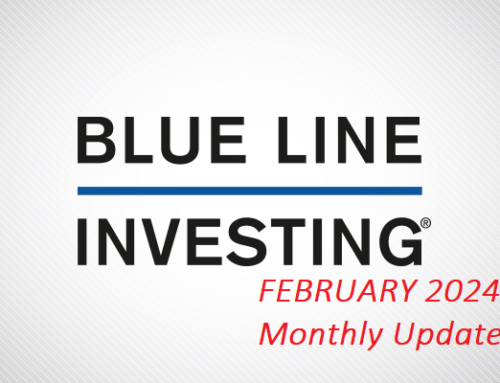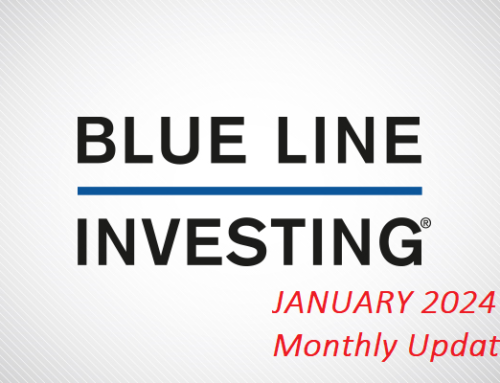
Chart courtesy of StockCharts.com
Blue Line Investing, Article 5 of 12
In our previous two articles we learned how observing the short and intermediate-term time periods can provide helpful clues as we attempt to identify the primary trend of an investment from a technical perspective. In this article we will explore what can be observed when looking at the same investment in the long-term from the Monthly perspective.
When viewing a Monthly chart there are 2 things we like to keep in mind. First, the rate of change is very slow, so relying on this perspective in isolation could prove detrimental. For example, the charts above represent almost 3 years of price activity and each vertical line in the first chart represents one entire month of price variation for the investment. Second, we have found this perspective can be helpful as a witness to assist in identifying the underlying primary trend within the Daily and Weekly perspectives.
As a quick recap, in our Daily article, we identified a Head-and-Shoulders formation that suggested a potential change in trend before the S&P turned down after the recent breakout. In our Weekly article, we identified what appeared to be a successful “test” of the breakout. So what additional information can we observe from the Monthly chart above?
We can observe a potential divergence. A divergence usually occurs when the price of an investment (the left-hand side of the chart above) and the price momentum of the same investment (the right-hand side of the chart above) are going in opposite directions. In other words, they diverge. We have found that price momentum tends to lead price, such that the price of an investment should be rising along with price momentum. While it is possible for price to rise as price momentum is consolidating (as it may be doing above), we believe it is important that price momentum remains above the zero bound.
The chart above is of the S&P 500 Index (S&P). It formed a temporary “price top” back in early 2015 (labeled “1a”). After a corrective phase, prices rallied to a new high during this calendar year (labeled “2a”). But while prices have been rising higher, you can observe that it has been with declining price momentum. Price momentum peaked during 2015 (labeled “1b”) and now, even with the markets making all-time highs, continues moving lower (labeled “2b”). So what could this suggest?
The divergence could be warning of a correction that may occur soon, or within the coming weeks or months. If so, we believe close attention should be paid to the Daily and Weekly charts, along with other investment witnesses, in attempt to implement proactive investment decisions in advance. Alternatively, if prices rally sharply over the coming weeks and months, the divergence may be negated altogether. Again, since Monthly charts develop over long periods of time, an investor shouldn’t draw any concrete conclusions from this particular divergence in isolation in our opinion.
Now that we have identified how to use 3 different perspectives for viewing any publicly-traded investment, in our next article we will explore the concept of usingwitnesses.
Disclaimer:
Technical analysis is a method of evaluating securities by analyzing statistics generated by market activity, such as past prices and volumes. Technical analysis attempts to predict a future stock price or direction based on market trends. The assumption is that the market follows discernible patterns and if these patterns can be identified then a prediction can be made. There are certain limitations to technical analysis research, such as the risk is that markets may not always follow patterns. This investment process should not be considered a guaranteed prediction of market activity and is one of many indicators that may be used to analyze market data for investing purposes. There is no guarantee that this process will be successful or will result in the projections contained herein.
Past performance is not indicative of future results. This material is intended for educational purposes only and is not financial advice or an offer to buy or sell any product. The investment strategy discussed may not be suitable for all investors. Investors must make their own decisions based on their specific investment objectives and financial circumstances. The opinions expressed are those of Blue Line Investing and are not necessarily those of Gordon Asset Management, LLC and are subject to change without notice. Blue Line Investing reserves the right to modify its current investment strategies based on changing market dynamics or client needs. Advisory services offered through Gordon Asset Management, LLC (GAM). GAM is an SEC-registered investment adviser. Registration does not imply a certain level or skill or training. More information about the advisor, its investment strategies and objectives, is included in the firm’s Form ADV Part 2, which can be obtained, at no charge, by calling (866) 216-1920. The principle office of Gordon Asset Management, LLC is located at 1007 Slater Road, Suite 200, Durham, North Carolina, 27703.
The S&P 500 Index is the Standard & Poor’s Composite Index of 500 stocks and is one of the most commonly followed equity indices. The volatility (beta) of an account may be greater or less than the index. It is not possible to invest directly in this index.




